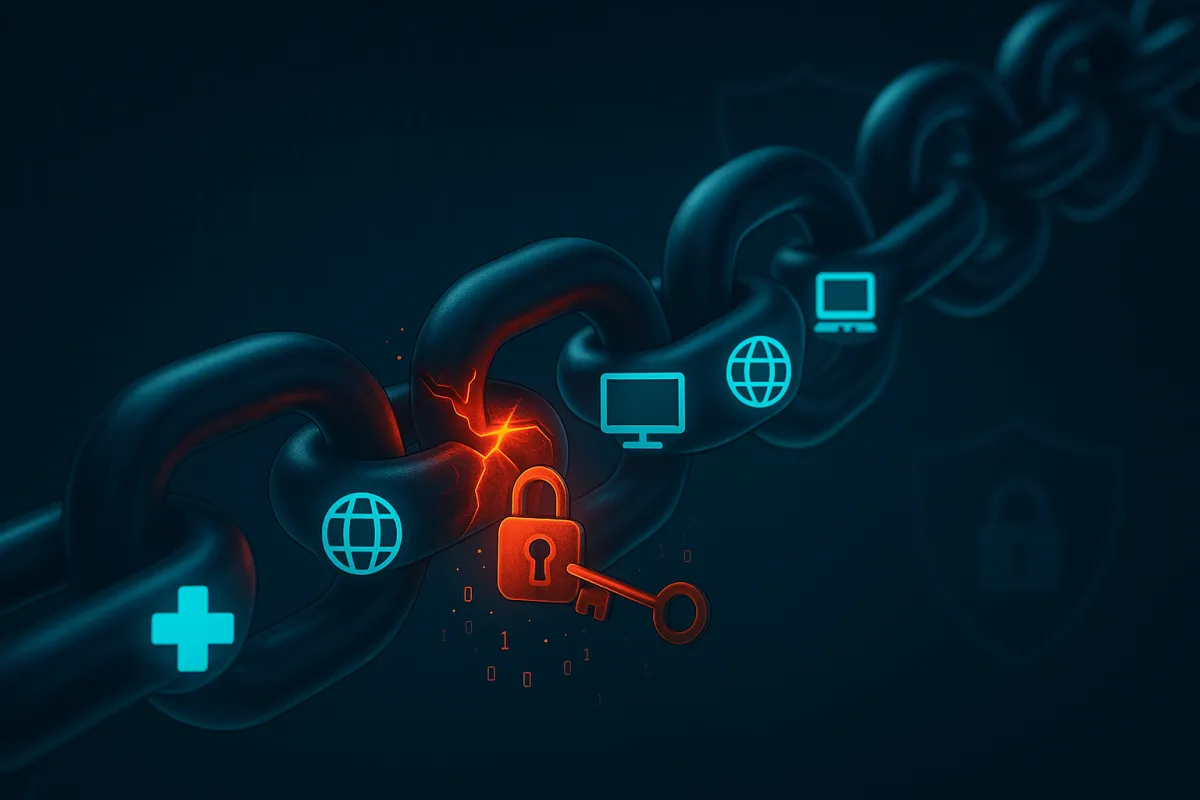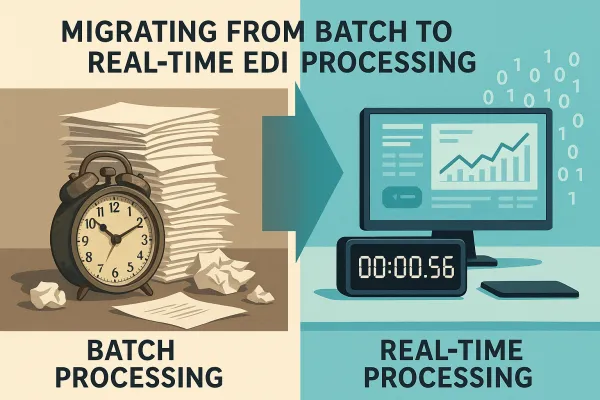The Complete EDI Security Incident Response Framework: How to Contain Supply Chain Cyber Attacks and Protect Trading Partner Networks in 2025

When the Conti ransomware gang targeted Faxinating Solutions in March 2021, posting 15 files to their leak site, it exposed just how vulnerable EDI providers can be. The small Quebec-based company serves major North American shippers including Walmart, Costco and Loblaws, handling EDI operations for about 20,000 companies through just 1,200 direct customers.
This incident represents a larger trend that's accelerated dramatically. According to a 2025 analysis, breaches involving supply chains surged by 68%, now accounting for 15% of all data breaches. The uptick began in April 2025, when cyberattacks with supply chain implications averaged 26 a month, twice the rate seen from early 2024 through March 2025.
For organizations managing complex EDI networks, this represents a fundamental shift in threat landscape. Supply chain attacks now cost 17 times more to remediate than direct breaches, with the average cost reaching $4.91 million according to IBM's 2025 Cost of a Data Breach Report. Your EDI security incident response framework needs to account for these unique challenges and cascading effects.
Understanding EDI-Specific Attack Vectors and Business Impact
EDI systems present attackers with several attractive entry points. The Faxinating attack came via a sophisticated phishing email from a trusted customer, despite the company using secure AS2 standards with encryption and digital certificates. This highlights a critical vulnerability: EDI environments require trusted relationships with hundreds or thousands of trading partners.
The multiplication effect makes EDI attacks particularly dangerous. When an attacker compromises one EDI provider, they potentially gain access to entire networks of suppliers and customers. One recent ransomware group claims that a single attack yielded data on 41,000 customers of one company.
Consider the typical EDI attack progression:
- Initial compromise: Phishing emails targeting EDI staff or trading partners
- Lateral movement: Exploiting trusted relationships to access customer systems
- Data exfiltration: Stealing transaction data, financial information, and supplier lists
- Operational disruption: Encrypting systems to halt critical supply chain flows
There's precedent for attackers leveraging EDI provider breaches to reach customers, as seen in a 2018 attack that impacted at least four U.S. pipeline companies. The interconnected nature of EDI networks means a single point of failure can cascade across entire industries.
The 5-Phase EDI Security Incident Response Framework
Building an effective EDI security incident response framework requires adapting standard frameworks to address the unique characteristics of EDI environments. NIST SP 800-61r3, the latest incident response guidance aligned with Cybersecurity Framework 2.0, helps organizations build a continuous, role-based, and risk-driven approach to cyber incident detection, response, and recovery.
Phase 1: Preparation - Building Cross-Organizational CSIRT Teams
Your EDI security incident response team needs broader representation than traditional IT security teams. NIST emphasizes that cybersecurity response teams need to be broader than they were in the past, moving beyond the "incident handler" model to include dedicated teams from across the company.
Include representatives from:
- IT Security: Network monitoring, system analysis, threat hunting
- EDI Operations: Transaction flow analysis, partner communication protocols
- Legal: Regulatory compliance, contract review, liability assessment
- Communications: Customer notification, media relations, regulatory reporting
- Procurement: Supplier relationship management, alternate sourcing
Prepare a written incident response policy with senior leadership support that identifies purpose and objectives, what constitutes an incident, prioritization or severity ratings, clear escalation procedures, and plans for notification and information sharing with media, law enforcement, and partners.
Phase 2: Detection - Monitoring EDI-Specific Indicators
Traditional security monitoring often misses EDI-specific attack vectors. EDR alerts that aren't continuously reviewed and public-facing systems lacking endpoint protection can leave activity undetected for weeks, as seen in one case where attackers exploited GeoServer vulnerability while the Web Server lacked endpoint protection.
Implement EDI-focused detection capabilities:
- Transaction anomaly detection: Unusual patterns in EDI message volumes, timing, or content
- Partner authentication monitoring: Failed login attempts, unusual access patterns from trading partners
- Data flow analysis: Unexpected data transfers or routing changes
- AS2/SFTP monitoring: Certificate anomalies, encryption failures, protocol violations
Teams need to centralize alerts and create a single data source to eliminate confusion, error, and redundancy while creating a rich data source from which trends, patterns, and anomalies can be extrapolated.
Phase 3: Analysis - Real-Time EDI Transaction Assessment
When an incident is detected, your analysis phase must account for EDI's interconnected nature. Focus on:
- Impact radius mapping: Identifying all affected trading partners and downstream systems
- Data sensitivity assessment: Evaluating compromised transaction types and confidentiality levels
- Business continuity impact: Determining which critical supply chain flows are disrupted
- Regulatory exposure: Assessing notification requirements across multiple jurisdictions
Phase 4: Containment - EDI-Specific Response Plans
EDI incident containment requires balancing security response with business continuity. You can't simply shut down EDI systems without massive supply chain disruption.
Develop containment strategies for different scenarios:
- Partner compromise: Temporarily suspending specific trading partner connections while maintaining others
- System breach: Isolating affected EDI servers while rerouting critical transactions
- Data exfiltration: Implementing network segmentation to prevent lateral movement
- Ransomware: Activating backup EDI systems and alternate communication channels
Include procedures for establishing out-of-band communications systems and accounts in case primary systems are compromised or not available, such as with ransomware incidents.
Phase 5: Recovery - Communication and Business Continuity
Incident response teams play a crucial role in identifying the scope of an incident, determining what data was compromised, and executing response plans, including notifying affected parties in accordance with applicable laws and regulations.
Your recovery phase must address:
- Trading partner notification: Coordinated communication to all affected partners with specific impact details
- System restoration: Phased approach to bringing EDI systems back online with enhanced monitoring
- Regulatory compliance: Meeting diverse notification requirements across different industries and jurisdictions
- Relationship management: Rebuilding trust with affected suppliers and customers
EDI-Specific Detection and Monitoring Technologies
Securing EDI environments requires specialized monitoring approaches beyond standard network security tools. EDR platforms that monitor endpoint activity in real-time can detect suspicious behavior, investigate threats and block threats like malware or ransomware, but they need EDI-specific configuration.
Implement these key technologies:
Secure Communication Protocols: Modern EDI systems should use AS2 standards with encryption and digital certificates, but monitoring these connections for anomalies is equally important. Configure alerts for certificate expires, encryption failures, and unusual connection patterns.
Authentication and Access Controls: Multi-factor authentication becomes complex in EDI environments where automated systems need seamless access. Implement role-based access control that distinguishes between human users and system-to-system connections.
Transaction Logging: Maintain detailed logs of all EDI activities with 6-7 year retention periods to support forensic analysis and compliance requirements. Log not just successful transactions but also failures, retries, and authentication attempts.
Real-Time Monitoring: Configure alerts for missing responses, rejected transactions, excessive retransmissions, and unexpected transaction volumes. These can indicate both technical issues and potential security incidents.
Leading TMS platforms like Cargoson, Blue Yonder, Oracle TM, and Manhattan Active offer varying levels of built-in security monitoring. However, many organizations need additional specialized EDI security tools to achieve comprehensive visibility.
Trading Partner Security Assessment and Onboarding Protocols
Your EDI security is only as strong as your weakest trading partner. Key recommendations include performing a criticality analysis to identify vendors whose compromise would cause the greatest operational impact, requiring vendor attestations that they follow secure software development practices, incorporating strong contractual protections including prompt incident notification and audit rights, and conducting regular assessments of vendor security practices.
Develop a comprehensive partner assessment framework:
Security Policy Review: Require all trading partners to provide current cybersecurity policies, incident response plans, and employee training documentation. Don't accept generic templates; look for evidence of regular updates and actual implementation.
Certification Requirements: Make ISO 27001 certification a baseline requirement for EDI providers and critical suppliers. For smaller trading partners who may not have formal certifications, require completion of standardized security questionnaires with periodic updates.
Technical Security Evaluation: Assess encryption practices, network segmentation, access controls, and backup procedures. Pay particular attention to how partners handle EDI credential management and system updates.
Incident Response Capabilities: Verify that trading partners have formal incident response plans that include notification procedures. Organizations should report attacks to authorities including federal cybersecurity agencies and law enforcement while notifying customers.
Many organizations struggle with vendor security visibility. Consider using security rating services to continuously monitor your trading partners' external security posture. Platforms like Transporeon, Alpega, FreightPOP, and Cargoson are increasingly building security assessment capabilities into their partner onboarding workflows.
Communication and Business Continuity During EDI Security Incidents
An increase of hybrid incidents that combine multiple attack vectors such as ransomware, supply chain breaches, and phishing campaigns demand more coordinated responses requiring cooperation across internal departments and external entities.
Your communication strategy needs to account for EDI's unique stakeholder complexity:
Internal Coordination: Establish clear communication channels between IT security, EDI operations, procurement, legal, and executive teams. Build resiliency around business processes first, with technology solutions coming later. Have paper-based backup processes ready for critical transactions.
Trading Partner Notification: Develop templates for different incident types and severity levels. Include specific impact details, expected resolution timeframes, and alternative communication methods. Don't rely solely on EDI systems for incident communication.
Regulatory Compliance: The regulatory landscape for data privacy and breach notification continues to grow more complex, with requirements varying widely by state, from Massachusetts prohibiting certain details in notifications to Utah mandating specific disclosures and Pennsylvania requiring credit monitoring for bank account information breaches.
Customer and Media Relations: Prepare messaging that explains the incident's impact on product availability, delivery schedules, and data security without revealing tactical details that could help attackers.
Leading TMS providers like E2open/BluJay, 3Gtms, and Cargoson are building incident communication features into their platforms, but most organizations still need standalone crisis communication tools.
Post-Incident Analysis and Framework Improvement
The cause, impact, and lessons learned must be reported to keep everyone aware and gain support for making improvements, with more comprehensive rather than less incident reporting and documentation yielding better outcomes over time.
Your post-incident analysis must address EDI-specific considerations:
Root Cause Analysis: Look beyond the immediate technical failure to examine process gaps, partner security deficiencies, and communication breakdowns. Was the incident preventable with better partner screening? Could it have been detected sooner with different monitoring?
Impact Assessment: Quantify both direct costs (system recovery, legal fees, regulatory fines) and indirect impacts (customer churn, supplier relationship damage, competitive disadvantage). EDI incidents often have longer-lasting business impacts than traditional security breaches.
Framework Updates: Security platforms require regular tuning with detection rules, threat intelligence, and alert thresholds all requiring adjustment and updating over time, including a schedule and methodology for tuning.
Testing and Simulation: Conduct regular tabletop exercises that include trading partner representatives. Test communication procedures, backup systems, and decision-making processes under realistic incident scenarios.
As EDI environments continue evolving with new integrations to platforms like ShipStation, Sendcloud, and Cargoson, your incident response framework must adapt to address emerging attack vectors and business requirements.
Staying ahead of the curve in incident response requires a continuous commitment to improvement by integrating emerging technologies, fostering collaboration with threat intelligence sharing and emphasizing resilience, helping organizations respond to threats effectively and build stronger defenses for the future.
Start by conducting a comprehensive assessment of your current EDI security posture and incident response capabilities. Identify gaps in partner assessment procedures, detection technologies, and communication protocols. Then prioritize improvements based on your organization's specific risk profile and regulatory requirements. The cost of preparation is always less than the cost of recovery from a major EDI security incident.





